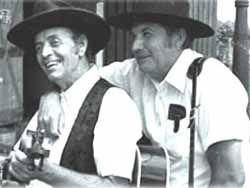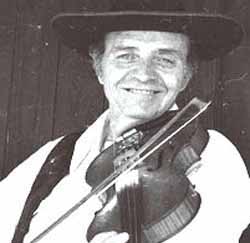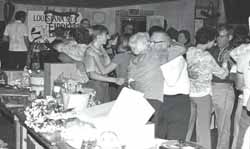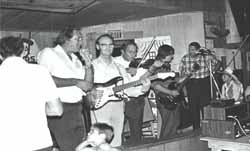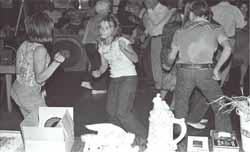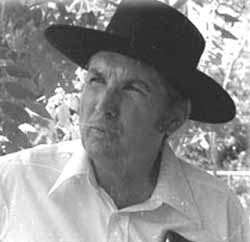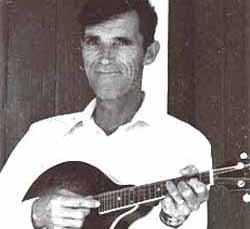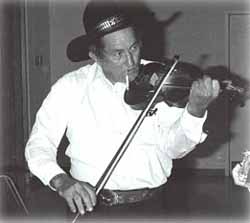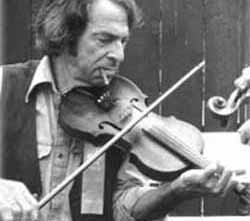The North Louisiana String Band
By Susan Roach
"To me music is a talent, a gift that's God-given; I think
you should use it for God's honor and glory . . . .It just
comes natural to us. It's a gift that God gives you. You
don't have to look at books and stuff to sing out of."
—Don Mayo
Introduction
From the rural north central area of Louisiana, the North Louisiana String Band is a group of musicians who are continuing the old-time British American music tradition, commonly referred to as "Hillbilly,"1 "Old-Time," or, as the band prefers, "Country." Many of the tunes in this dance tradition, which includes waltzes, reels, and breakdowns, have roots reaching back to the musical traditions of the British Isles. These traditions were brought with the Anglo-Celtic immigrants to the United States Upland South and eventually to North Louisiana by immigrants from Virginia, the Carolinas, Georgia, Alabama, and Mississippi. However, the musical form that gradually developed from this reservoir of folk music in the American rural South was heavily influenced by other musical forces such as blues, minstrelsy, jazz, and popular music.2
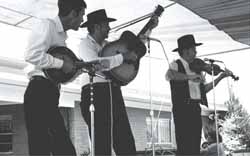
The "pure" British American folksong tradition usually involved unaccompanied solo singing in a rigid impersonal style for small group entertainment. With the eventual availability of instruments, the individual performers often joined friends to form a string band.3 The fiddle was one of the first available instruments, brought into the South as early as the seventeenth century, while the five-string banjo, adapted from the African bania, did not become popular in the southern mountains until the mid-19th century. The banjo, with the guitar and mandolin, which gained popularity in the late 1800s and early 1900s respectively, did much to change the folk singing style, particularly by changing rhythm and timing and flattening minor keys and abandoning modal structure to allow easier accompaniment.4 These were the instruments commonly found in the hillbilly string band. Later the upright bass, borrowed from jazz, was frequently incorporated into the string band to provide a heavier beat
This string band format was thriving in the 1920s when the commercial phonograph companies, including Columbia, Vocalion, and Okeh, decided to include country musicians on 78 rpm recordings.5 The first generation of country music performers to be recorded may be termed "folk" rather than "professional" musicians, men from farming or other occupations who played music for their own pleasure or for the Saturday night party. These recordings found an eager market in the South and gave musicians access to numbers from other areas, thus influencing traditional folk styles.
The advent of commercial radio broadcasting during the same period also had a profound influence on hillbilly music. Perhaps the greatest impact of radio was from the Nashville WSM Grand Old Opry (first called the WSM Barn Dance), begun on November 28, 1925. The North Louisiana String Band members all recall the development of radio and the popularity of the Grand Old Opry in the rural communities of their youth. Fiddler Eddie Raxsdale remembers the technical difficulties of early radio:
I remember the first old radio we had in our home. At first it had earphones—that was the only way you could listen to it was plug the earphones in it. Then later on somebody got smart and invented a speaker, and it looked like a great big tuba that you see in these brass bands. Boy, they really had something then, but you still had that wolf howl when somebody down the road was tuning his set in; boy, it would knock your ears off—oooooh! That'd go on for hours, and static! You never heard as much static in your life as it was on the radio. And the only stations you could get really was at night, and then WLW Cincinnati, and then you had WSM in Nashville which everybody favored on Saturday night because of the Grand Old Opry.6
Herman White also recounts technical problems, but he did not let them interfere with listening to his favorite show: "We used to have a radio you could hold your hand on the back of and hear the Grand Old Opry. I'd hold my hand on it for hours . . .." The members of the North Louisiana String Band were the first generation of folk musicians to grow up with radio, and it, no doubt, had a profound effect on their music.
In spite of its popularity with rural traditional musicians, the Grand Old Opry and hillbilly music popularity was not universally admitted in Louisiana. In fact, many saw the music as bearing the stigma of lower class and ignorance, even though it was the music of their parents and grandparents. This caused ambiguous feelings toward country music, resulting in behaviors such as those recalled by Eddie Raxsdale: "It wasn't that they didn't like it [country music]; they liked it but they didn't want the next door neighbors to know they listened to the Grand Old Opry. They'd close the doors and pull down the shades and the windows, and then turn on the radio." A similar ambiguity resulted from the association of country music with wholesome family entertainment and gospel songs on one hand, and wild parties, honky-tonks, dancing, and liquor, on the other hand. Certainly, the early church "singing schools" of the late nineteenth and early twentieth centuries taught the harmonies that were adopted by country musicians, and the instruments of country music were employed by gospel singers. However, country music was often associated with brawling and drinking, even at typical house dances. According to Troy DeRamus, band leader, the early house dances of his youth would have a fiddler or two who commonly knew eight to ten numbers and would play for a half an hour or so and then go outside for a drink. Often brawling would break out. Troy recalls one such night when a fight resulted in the men tearing all the pickets off a fence for use in the fight.
Undoubtedly, the movement of local country music in the 1930s into the club, or honky-tonk, helped feed the negative stereotype of country music, but it also influenced the development of country music, modifying rhythm and instrumental style.
In addition to these commercial and urban influences, North Louisiana country musicians were also affected by nearby Texas Swing and Cajun regional music. Texas, or western swing,7 began its development in the late 1920s with country musicians such as Bob Wills adding a jazzy style and additional instruments to the traditional country string band. The geographical proximity of the Louisiana Cajun culture provided easy access to their accordion-fiddle based dance music.
These geographical and cultural factors form the complex musical milieu in which the North Louisiana String Band members spent their formative years. Although the rural backwoods of North Louisiana, settled mainly after 1830, was more isolated than many other areas in the South, and although these musicians learned their music in the folk tradition, the influence of these outside forces on their developing musical styles cannot be overlooked. Even so, their country music still retains much of its distinctive old-time flavor, regardless of the fact that band members are also competent in other more recent country styles from the Nashville empire and are familiar with other developments such as bluegrass.8 Given their awareness and competence in the different styles in modern country music, their preference for old-time music is basically a matter of aesthetic choice. They find most appealing and feel most at home with the music of their rural southern hillbilly heritage—old-time country.
The North Louisiana String Band: Beginning and Development
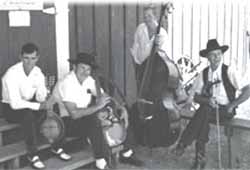
Although all the members of the band are rooted in the old-time music tradition, the band itself is of recent formation, and its existence is the result of the interaction of the new state folk arts program, an academic folklorist, and folk musicians. It all began when Nick Spitzer, folk arts coordinator for the Louisiana Division of the Arts, planned the Louisiana Folk Arts Conference to focus on bringing together folklorists, anthropologists, media experts, federal and state officials, and the interested public to discuss how to best identify, present, and preserve folk art and folklife in Louisiana. As the final evening activity of the conference, Spitzer arranged a concert to present four major types of Louisiana folk music, including blues, Cajun, hillbilly, and zydeco.
Since I was doing folklore research in North Louisiana, Spitzer called on me to find some old-time hillbilly musicians, preferably a string band, from my area to represent traditional Anglo music in the concert. Although there were many bluegrass bands in the area, I was not able to locate an old-time string band still playing. I did find some old-time fiddlers, some of who had switched over to bluegrass style. I focused on an old-time fiddler in his seventies, Roy Beckham from Lincoln Parish, who had continued to play hillbilly fiddle. In recent years, though, he played only occasionally at family get-togethers with his guitarist sister, Lucille Deason, or with a few friends in the community. When Mr. Beckham decided that he was not up to making the five-hour trip south to Baton Rouge for the concert, I was pressed to locate other musicians in the short time left before the concert.
Fortunately, I happened on a local newspaper item about a local seventeen-year old country-western singer who had been invited to make a guest appearance at the 1979 Louisiana State Fiddling Championship in Boyce, Louisiana. Although this competition had been held annually for nine years, neither Spitzer nor I had heard of it, probably because it was a relatively small, privately-run festival, which had received little publicity. Hoping to find some old-time fiddlers further south in the central part of the state, I went to the fiddling championship on Sunday, April 22.
Upon my arrival in Boyce at a place called the Old Barn, I found the atmosphere promising. The event was taking place in a large dull red, barn-like structure situated in what appeared to have once been a pasture. An old wagon and various old farming implements were scattered about. In spite of a heavy rainstorm, many cars were parked in rows and under the large shade trees. Inside the barn were rows of folding metal chairs focused on a small wooden stage. The rough, unpainted walls were decorated with old musical instruments, hand-printed signs, snapshots, and more farm and domestic tools; the unpainted floor and low plywood ceiling reverberated with the sound of the fiddles.
I explained my search for traditional country musicians and string bands to the festival organizer, Troy DeRamus, who knew of no remaining organized string bands; however, he did know some good old-time musicians around that he thought he could get together. He suggested that I talk with Ray Beebe, one of the fiddle contestants, who was warming up in the back room, to see if he would be interested in playing for the concert. Troy felt that if his old friend would agree to play fiddle with his own rhythm guitar, they would have the basis for a strong act to which he could add other traditional performers. When I talked with Ray Beebe, a resident of Colfax, he agreed with Troy to put a group together by the May 5th concert. When the contest was over, we talked to the new 1979 champion, Jamesette Kyle, from Sharp, Louisiana, who consented to play twin fiddle with Ray. On filling out the concert contracts, I asked Troy what the name of the band would be. He said it did not really matter and agreed to go along with Spitzer's pre-conference publicity which billed the group as the North Louisiana String Band.9 Having heard these three musicians play and having seen their deep interest in old-time music, I left the contest reassured with a signed contract for the concert, but still never having heard the soon-to-be-formed string band. Nervous about my gamble, I kept in touch with Troy by phone to hear of the band's progress during the next two weeks. He filled out the band with some old friends—a mandolin player, Don Mayo of Alexandria, and a bass fiddler, Dewy Cox of Pineville. Although some of the members had "jammed" or done some "shade tree pickin'" together, none had played together as an organized group.
Nevertheless, the gamble paid off with the big success of this five-piece band at the May 5th concert. After practically stealing the show with their waltzes and breakdowns, the group, on returning home, was inspired to continue playing together, and later was booked for a couple of local engagements. Seeing their success, the Louisiana Division of the Arts contracted the band to participate in the Artist-in-schools program to perform concerts and workshops for schools in Shreveport, Monroe, and Ruston. The folk arts program also made information on the band available to area festivals, which gave the group further exposure and offered more performance opportunities. During the next year, the band played for a number of festivals including the Louisiana Art and Folk Festival in Columbia, the North Louisiana Arts Festival in Grambling, the New Orleans Jazz Festival, the Festival of Traditional Arts and Crafts in New Orleans, the Governor's Inaugural, the Shreveport Red River Revel, the Shreveport Blues Fest, and the Natchitoches Folk Festival. The band did not remain static during those months; because of work schedule problems, Jamesette Kyle left the group, leaving one fiddler, Ray Beebe. For a brief time, Dennis Elliott, banjoist, joined the group to make it a five-piece band again. Also substitutes on the bass fiddle were added; Herbert Meche of Alexandria filled in until spring, 1980, and Mayo, who remained from the original group to form the four-piece band which recorded the present album.
The making of this album was also the result of the cooperation of state and academic folklore programs. After the concert, Nick Spitzer and I discussed the possibilities of recording the band, and in late 1979, the Louisiana Division of the Arts suggested that the Louisiana Folklife Center at Northwestern State University in Natchitoches record the band to document the North Central Louisiana fiddling style. Louisiana Folklife Center director, Don Hatley, with support from the state and a Nagra recorder from the American Folklife Center, supervised the recording sessions set up at DeRamus' Old Barn and the recordings from the 1980 Natchitoches Folk Festival performances. The band itself was eager to make the recording and had orders for over a hundred records long before the record was released.
Shortly after their recording and the Natchitoches Folk Festival, the band went through a major change with the sudden illness and death of Ray Beebe. Given the long-time friendship between Troy and Ray, and Troy's deep sense of loss, the future of the band was in jeopardy. However, wishing to preserve the old time fiddling style that Ray had worked on so faithfully and feeling that the band had to honor a prior commitment to play the Red River Revel in October, Troy brought in another fiddler, Eddie Raxsdale, who had also won the state championship and had also occasionally played with some of the other musicians in the band. Eddie's new energy and the band's dedication to continuing old-time music helped sustain the group through the crisis, enabling them to "go on with the show."
Although the band was formed in an attempt to serve the interests of academia and politics, its members were drawn from what may be termed a musicians' sub-culture spanning several communities bound together by a great love for country music. Admittedly, some members of the band, especially Troy DeRamus, are somewhat self-conscious of their roles as preservationists. Also, most of their performances have been outside the folk tradition of their communities and instead in the realm of the popular festival. However, applied folklore projects such as this one cannot help but interfere in the traditional context in hopes that the tradition will be stimulated to perpetuate itself and be strong enough to withstand the interference. Such seems to be the case with the North Louisiana String Band, who has again found that they do have an audience for their music. In fact, on the release of this record, band members' friends and neighbors have bought the record to hastily reclaim the music from their rural heritage. The hours I spent observing and talking with the band through months of concerts, recordings, and interviews reveal that the group members share common roots not only in traditional music but also in a traditional rural southern background in Louisiana. Their individual biographies show the strength of their backgrounds and their music in their lives.
The Men And Their Music
Ray Beebe
Ray Beebe, born in Lena, Louisiana, November 25, 1925, had a difficult childhood with his father dying when he was only three. A few years later, his new stepfather made his first fiddle from a cigar box. For some time, Ray was ill, becoming so weak over time that he had difficulty getting to the fields of the farm to work. Because of the isolation of their farm and difficult transportation, it was some time before his family got him to the hospital for treatment of what was found to be hookworms. After his recuperation, he learned to play fiddle from an uncle. Ray jokingly remembers: "I was too lazy to do chores, so I played the fiddle." He also remembered walking several miles to a friend's house just to learn something new for his fiddle. According to his brother, when Ray was a boy, two things could always be found in his pockets—fishhooks and rosin for his fiddle bow. By the age of thirteen, he was playing for money and traveling around trying to learn more tunes.
He continued to play after he joined the navy in 1943, playing smokers on ships, and once playing for President Roosevelt. After his stint in the navy, Ray tried several occupations, but his fiddling was never far away. According to Troy DeRamus, when they met in 1946, late one night at Aunt Lucy's Cafe in Pineville, Ray was a ward aid on his way to work the eleven to seven shift at the state mental hospital. Ray had his fiddle with him, which he played in the office during the night. After he left this job, he attended Louisiana College for a year and then went to Texas where he pastored a Pentecostal Church. On his return to Louisiana around 1949, he went to electronics school and later became an electronic technician in the National Guard. Later he ran his own electronic repair shop for about ten years and then, in semi-retirement, became a rural mail carrier.
He continued to play barn dances during the 1950s and 1960s and, in the 1970s, played a dance every Saturday night at Dube Hall, an activity center for an Alexandria Catholic church. Ray often went to fiddle conventions in Arkansas, Mississippi, and Louisiana to compete and learn new tunes. He is said to have had over four hundred tunes in his repertoire and to have practiced up to three hours or more every day. Perhaps the greatest commercial influence on Ray Beebe's style and repertoire was Roy Acuff. Like Acuff in his earlier years, Ray played the fiddle and sang at the same time, although unlike Acuff, who lacked confidence in his fiddling, Ray's fiddling exuded his confidence and pride.
Troy DeRamus, who played music with Ray since 1951, speaks of Ray's relation to his music. "I don't believe any man alive ever loved his instrument or his music more and was more dedicated than Ray Beebe." On the day of the second recording session for this record, Ray was in extreme pain, which he attributed to an old ulcer flare up; nevertheless, he fiddled all afternoon. A few weeks later on June 28 and 29, when he played three sets at the Natchitoches Folk Festival, he was still in pain. Even so, he put enormous vitality into his performances. As Eddie Raxsdale, another fiddler, put it, "He was a good showman. I got to give him credit for the fact that he could get out there and he could work a crowd. He had a knack about him I just don't have." Ray demonstrated this charisma vividly at a workshop with the band at the Natchitoches Folk Festival when he took obscure requests from old-timers and had everyone in the hall keeping time and cheering for more.
A few weeks later, when he was hospitalized for surgery, he learned that his pain during the past weeks was from cancer. During the next three months, the band was idle, and Troy spent many hours with Ray. Troy and his family and friends organized a benefit for Ray, held on August 29, when a number of musicians donated their time to play the dance. Family and friends and local businesses brought cakes and donated articles from radios to rockers for an auction. Pots of chicken gumbo were consumed at a dollar per bowl, and everything was sold, with some items being given back and sold again, all to raise almost three thousand dollars. It seemed that the people were eager to give something in return to Ray, who had given them such enjoyment in his years of music.
When Troy and his family saw Ray after the benefit, he was pleased, and although he was weak, he helped Troy's seven-year-old son, Johnnie Lee, whom he had been teaching some old-time fiddle, tune his fiddle and then played "Boil Them Cabbage Down" for him.
Ray Beebe died three weeks later on Saturday, September 21, 1980, at the age of fifty-three. Three actual-size floral fiddles on and around his casket marked his funeral, symbolizing how he would be remembered in the hearts of all who heard him play his fiddle.
Troy Deramus
Troy DeRamus was born in the sawmill town of Glenmora on February 9, 1932. Although his father played fiddle, Troy was not encouraged by his parents to play music because his mother saw fiddling as having a negative influence in their religious home: "We sung a lot of gospel music, and Daddy said table grace, and we didn't hunt on Sunday and didn't curse around the lady folk in the house; it wasn't permitted, and no drinking whatsoever was permitted in the home." Troy was impressed at a young age with his father's music, even though he only played rarely. When asked what really inspired him to play country music, Troy said:
We always listened to the Grand Old Opry, which was big stuff to the country people, and it was about the onliest thing we had that the whole family could really enjoy. I think I was inspired by that. Roy Acuff, I think, was the one factor in my life to do the type music that we do here today. I think that it was always there with me. And there was one other thing when I got up a little older, my sister's husband (before they were married actually) had taken up the guitar. He knew three chords—C, G, and D, and he taught me those, and from that I started. . . . I'd meet him in the yard and ask him how to make C or G, and before he could see my sister, he'd have to stop and show me a chord on the guitar.
After much persuasion from Troy, his father, and sister, his mother agreed to let him have a guitar, as long as he played outside the house:
When I was thirteen, my mother sent me to town to buy a guitar. She called Pinkison Murphy Music Company and told them when I came in there to let me have the guitar I wanted and she would pay five dollars down and a dollar a week. I bought a guitar that cost eighteen dollars. . . . I could have bought a good guitar for fifty dollars, but we were so poor through the years and I was so indoctrinated with buying something cheap to get by that I went down there instead of going to the rack and picking out a good guitar, I went and picked out a cheap one, which was a mistake. The strings were high on the neck, and it was an F-hole guitar; it didn't have any tonal quality.
In the early 1940s, radio show performers also had a big influence on Troy. He spent many boyhood hours hanging around the KALB studio in Alexandria, listening to performers such as Jelly Elliott and the Singing Cowboys and Sleepy Ebert. According to Troy, "I got to going there so much that they'd let me go in the studio. They'd set me a chair inside the studio while they was on the air, and I'd set there and was just dumbfounded by that music." Before Bob Anderson started playing with them, they had Johnny Ford, and he fascinated me with his fiddling. It just captured me totally. I loved the fiddle, and I love it like nobody you ever saw.
When he was fourteen, Troy formed his first band, which included a lead guitar, bass, and his rhythm guitar. Later he and a mandolin player, Lloyd Murrow, formed a duo to play old-time country at local theaters for the Saturday morning warmup shows, which were broadcast over the local radio. He remembers: "Back then we had a radio program and Eddie had one; we'd get cards and letters from all over the country. Lord, back then our music was strong." It was around 1944 when he first met fiddler Eddie Raxsdale at the Alexandria Hillbilly Jamboree, to form what would be a long lasting friendship.
For one year, Troy worked for thirty-five dollars per night in Baton Rouge clubs as a one-man band, playing bass drums, symbols, and guitar and singing numbers by artists such as Ernest Tubb. Not liking the club life, he went back to Alexandria to settle down and eventually went into the auto parts business. About this time he met the Mayo Twins, Don and Dan, a duo of mandolin and guitar with a beautiful country harmony. After months of trying to buy time on a local radio show, Troy managed to buy thirty minutes per week to sponsor the Mayo Twins Show. This era was the beginning of idle times for country music in the area.
In 1970 Troy and his wife, Edwina, took over the operation of the Old Barn Dance, which had been established in Alexandria in 1945 and gone through several operators and locations. Now located in a building next to his home, the Old Barn Dance still provides family entertainment every Saturday night with music from Troy's Country Kings band. Although Troy's band plays some Cajun and modern country-western music with heavy bass and drums and amplified guitars, Troy still prefers the older sound of his newly formed string band: "My music was always separated from modern country. A simple melody is my approach to music. . . . I don't like fake or swing. I like things played for the beauty of it. The blending of two or three instruments totally satisfies me."
Don Mayo
Don Mayo, mandolin player was born March 11, 1934, on the "Eight Mile," a road near Otis, Louisiana, off the Leesville highway. His father, a Louisiana native, was a train engineer, Baptist preacher, barber, and homestead farmer. Don, one of eight children, remembers living in a three-room log cabin until he was ten years old. Then his family bought a forty-acre farm where they raised cotton, corn, and peanuts. His father "rapped" a Sears and Roebuck guitar, which along with gospel singing at church, provided Don's first musical interest. About the age of fourteen, Don bought himself a fiddle: "I don't know why, but I never could get that thing going for me." A couple of years later, he traded the fiddle in on a mandolin, which his brother-in-law taught him to tune and play. With his first three or four chords, the first song he learned was "Red River Valley."
Meanwhile, his twin brother, Dan, picked up the guitar, and the brothers sang together. They played a few breakdowns and hoe-downs at home that they picked up mostly from the radio, but their favorite music was gospel, especially that of the Louvin Brothers,10 known for their pure old-time style. Known as the Mayo Twins and playing such gospel songs as "Keep Your Eyes on Jesus," "Satan Lied to Me," and love songs such as "When I Stop Dreaming" and "My Baby's Gone," they began playing for parties, schools, and church revivals. Don sang soprano or lead while Dan sang tenor; or Dan would sing high tenor while Don sang low tenor or alto. They became known for having the most perfectly blended harmony in the area. They played mainly Pentecostal churches, which permitted string instruments in their services, unlike the Baptist church in which they were raised. By the time they were about eighteen, the Mayo Twins had their own gospel radio show on Alexandria KDBS, sponsored by a local grocery store. In the early 1960s, they cut a forty-five record with their original compositions, "God Heard My Plea" and "My Mother Praying." They then played a road show, traveling in Mississippi, Texas, and Louisiana, until marriage broke up the group.
Employed as a department manager at a local discount store in Alexandria, Don, along with his family, still does some gospel singing at home, and he plays mandolin and harmonica. His daughter has followed his musical interest and plays classical piano. The string band is the first group Don has played mandolin with in recent years. He has no trouble switching over from gospel to old-time country, although they often have a different beat. Like his ability to sing harmony, this also "comes natural" to him. In fact, Don attributes this natural ability to a close relationship between religion and his music: "To me music is a talent, a gift that's God-given; I think you should use it for God's honor and glory. . . . It just comes natural to us. It's a gift that God gives you. You don't have to look at books and stuff to sing out of."
Herman White
Herman White, bass fiddler, was born on a farm in Leander, Louisiana, in Vernon Parish on March 27, 1930. He grew up on this farm, helping with the farm chores. He recalls being fascinated with music at an early age:
My dad and uncle used to play at night, and whenever I was a little kid and have to go to bed, I wouldn't go to sleep. I'd listen to them a-playing; my uncle had a guitar and my dad played the fiddle. They'd play till about 10:30 to 11:00 at night. They played hoedowns. He [Father] played banjo, guitar, and fiddle. He learned how to play the fiddle on one of these cigar box fiddles when he was seven years old.
The first instrument Herman played was the guitar, which he bought himself:
I picked cotton and saved my money and ordered one from Montgomery Wards when I was about eight or ten. It was my idea; I just wanted one. . . . When I ordered mine, well, I went to the post office about five miles away to see if it had come in. I went every day until it come in. I got my dad to show me the chords—G, C, and D on it and then after I learned my chords, I got him to get his fiddle and I played with him.
In addition to guitar, Herman also played some harmonica as a boy and later played drums briefly. Herman's music remained in the family for some time. He and his sister, playing guitar and mandolin, sang western songs such as "Cool Water" and "When Pay Day Rolls Around" for local parties.
In the early 1950s, Herman on guitar and his brother who had taken up fiddle began playing country music shows at theaters and schools. Gradually, the band grew to an eight-piece band known as the Louisiana Ramblers and played area clubs such as the Moonlight Inn at Marthaville, Ruth's Garden at Leesville, and Club 20 on Highway 1.
After tiring of playing clubs, he found his real musical love—the bass. He bought an old upright bass fiddle around 1958 and began trying to play it by teaching himself and watching others play. Then he became intrigued with the electric bass after seeing a gospel group playing at the local television station. He began actively playing bass for gospel music in the early 1960s when his brother organized the Gospel Light Quartet. For a year or so the group played church concerts. Herman stayed with the group through two changes in singers and names to the Magnolia State Quartet and the Happy Travellers. They played in Texas, Arkansas, Louisiana, and South Carolina; the groups also recorded several songs. Later in the mid-1960s, he sang and played bass with the Mayo Twins' four-piece band, which performed mostly Louvin Brothers- type gospel for schools and homes in the area.
Herman, who presently resides in Alexandria and does maintenance work, likes playing old-time country music and still has a "greater love for gospel music than any other kind."
Eddie Raxdale
Eddie Raxdale, the new fiddler for the band, was born November 13, 1922, in Turkey Creek in Evangeline Parish, but was raised in Alexandria by an aunt and uncle after his parents' early deaths. His uncle [his father's brother] had played cornet in a steamboat orchestra, and his aunt was an educated pianist. Also, Eddie was told that his father had been quite a good fiddler. It is not surprising that Eddie also became interested in music at an early age, attracted to the fiddle when he was about seven and then to the piano:
The fiddle was the first thing I picked up. I think I got my inspiration from my uncle. He was a real fine fiddle player; he had a fiddle; I guess he played it more than anything else he owned. He didn't want anyone to touch his fiddle, especially a kid, and I'd wait until he was gone—he didn't keep it in a case—he kept it on top of an old upright piano. I'd sneak it down while he was gone and try a little tune or town on it, and I'd put it back up when I thought he was coming back. He slipped in on me one day just as I learned to play. The first tune that I learned was "Jingle Bells," and I was playing it on one string with one finger, and I was sliding up and down. It sounded horrible, but you could recognize the tune, and he was amazed at me. He said, "Are you interested in learning how to play a fiddle?" I said, "Yes I am." He said, "You quit doing what you're doing right now. You'll never learn nothing like that." So he taught me how to run the scale on the fiddle and went and bought me one—a little three-quarter size.
His uncle also taught him to read the melody for violin, but Eddie did not pursue formal music training and continued to play, mainly by ear.
Some of the first songs he learned were old country breakdowns like "Turkey in the Straw" and "Old Joe Clark." He learned some from listening to old cylinder phonograph records, but he learned much more from area fiddlers:
I used to love to go to the parish fair when I was a kid, and they'd have fiddling contests, and they had a lot of old-time fiddlers at that time. A lot of the older men played fiddle, and they were real artists, and they'd have a fiddle contest and a barn dance. We'd go down there and just sit for hours and hours and listen to them. And I just thought that was the finest sound I'd ever heard in my life. I just kinda fell in love with it, and I've never been able to get away from it.
Eddie's first "little old group" consisted of a couple of friends who played guitar and banjo. They played for friends and neighbors for cake and coffee. His first organized band work was as fill-in musician for Jelly Elliott and the Singing Cowboys, where he played some piano, upright bass, and fiddle. In the 1940s, he briefly worked with Sheriff Woody and the Calumet Indians, playing theaters to advertise Calumet Baking Powder. He also worked with a number of other area bands and held a variety of jobs on farms and in sugar mills, cotton gins, and sand and gravel plants.
Presently, he works as a machinist and operates a trailer park. On weekends he plays fiddle with Troy DeRamus' Country Kings for the Old Barn Dance. Occasionally, his daughter and son, whom he started out in music, will join him to play private parties.
It is evident that Eddie takes old-time country music seriously and yet finds it fun. When he joined the string band, he ordered an expensive new fiddle to play his favorite kind of music. He modestly comments on his music: "If I didn't enjoy it, I wouldn't even have a fiddle; I'd just walk away and forget about it. So that's the reason I stayed with my style of it. I don't consider it anything outstanding. I can play enough to satisfy me, and that's about it."
The North Louisiana String Band LP 37882
Side One
All of the numbers on side one are excerpted from the North Louisiana String Band's last performance with Ray Beebe on fiddle. This live performance on June 29 at the 1980 Natchitoches Folk Festival reveals both the strengths of the group and the individual members. Troy DeRamus, as the band organizer and leader, does the emceeing, introducing the songs and performers and holding the performance together, while Ray Beebe's spirited fiddle and vocals give vitality. The mandolin and bass, along with the old-time tenor and bass harmonies of Don Mayo and Herman White and the rhythm guitar of Troy DeRamus, fill out the group.11
1. Ida Red
This old-time novelty number, which begins side one, emphasizes both lyrics and breakdown instrumentation and has been recorded by country musicians, including Bob Wills and Roy Acuff. Combs (1967: 92) attributes the tune to black origins. There are many variants in the British American tradition. Lomax (1960: 110) cites Texas variants, and Randolph (1950: 442) gives Arkansas variants, which are significantly different from Beebe's version. The North Louisiana String Band usually began performances with this song so that concerts began with the solo fiddler, seemingly to demonstrate the historical development of the string band.
Well, I'm a little sick and outa my head
'Cause I'm a plumb fool about Ida Red
Ida Red, Ida Red, I'm a plumb fool about Ida Red.Well, Ida Red, she ain't no fool,
She's quick as an elephant and stout as a mule.
Ida Red, Ida Red, I'm a plumb fool about Ida Red.
Ida, Ida, I'm a plumb fool about Ida Red.Ida Red and Ida Green
She's the prettiest girl I ever seen.
Ida Red, Ida Red, I'm a plumb fool about Ida Red.Ida Red and Ida Black
Wish I had my dollar back.
Ida Red, Ida Red, I'm a plumb fool about Ida Red.
2. Louisiana Waltz
This anonymous waltz which has an old-time flavor and a slight Cajun tonality on the bow, is called "Louisiana Waltz" by the band. According to Troy DeRamus, "Ray is the onliest one I ever heard play it. He may have heard it from one of the old nesters . . . . It might have been his own tune. Ray was modest and he didn't boast, or it could have been early in his career, and he wouldn't take credit for it because it was a simple tune and most fiddlers don't want to be associated with simple tunes." Thus Troy's answer on the ambiguous origin also reveals an aesthetic standard of creation of traditional sounding tunes.
3. Golden Slippers
Ray Beebe's fiddle and Don Mayo's mandolin trade off leads in this favorite dance tune of the Upland South, which actually originated in the 1870s in the minstrel tradition. Printed sources attribute its composition as "Dem Golden Slippers" to black composer James A. Bland (White1958: 106; Jackson 1976: 276). The original gospel spirit of the music, which also hints of ragtime, was adapted to Anglo folk dance tradition. The tune was recently used in the mass media to advertise a breakfast cereal.
4. Will The Circle Be Unbroken
This old standard, made famous by A. P. Carter and the Carter family's recording is a favorite of the band and their audiences. The number is a good vehicle for the band's old-time harmony. Troy DeRamus sings lead and is joined with Don Mayo's tenor and Herman White's bass. White describes harmony singing, learned by ear, as "Hearing one sound and thinking another. It's a tone you have to have in your mind. Instead of thinking a note, you think a sound."
I was standing by my window on a cold and cloudy day When I saw that hearse come rolling for to carry my mother away.
(Chorus:) Will the circle be unbroken, by and by, Lord, by and by? There's a better home a-waitin' in the sky, Lord, in the sky.
Undertaker, undertaker, undertaker, please drive slow
For this party that you're carrying, Lord, I hate to see her go.(Chorus)
I followed close behind her, try to hold up and be brave
But I couldn't hide my sorrow when they lowered her in that grave.(Chorus)
5. Cotton-Eyed Joe
This old square dance or breakdown tune has many variants (Combs 1967: 229) and has been recorded frequently by stars such as Bob Wills and recently adapted by progressive country bands and popularized as a dance number in the film Urban Cowboy. Ray Beebe's lyrics, which may be of his own creation, differ considerably from available variants. His references to fiddling competition, whether his own creation or his choice of traditional variants, reflect his deep interest in excellence in fiddling.
Cotton-eyed Joe's a fine old man,
I'll beat him a-fiddling, if I can.
Where did you come from, where did you go,
Where did you come from, Cotton-eyed Joe?
Where did you come from, where did you go,
Did you beat him a-fiddling? Hell, no.If it hadn't been for Cotton-eyed Joe,
I'd been a married man a long time ago.
Where did you come from, where did you go,
Where did you come from, Cotton-eyed Joe?
Where did you come from, where did you go?
Did you beat him a-fiddling? Hell, no. . . . Try it again.Where did you come from, where did you go,
Where did you come from, Cotton-eyed Joe?
Where did you come from, where did you go,
Did you beat him a-fiddling? Hell, no.
6. Over The Waves
A favorite waltz in the southern dance tradition, "Over the Waves" may have grown out of a late nineteenth century Victorian parlor tune. At any rate, it remains a popular number among old-time Louisiana fiddlers and has been passed along traditionally for at least the last two generations. As Troy DeRamus remembers, "I don't remember learning it; it was always there; my daddy played it."
7. Whoa, Mule, Whoa
The specific origin of this popular number is unknown, but goes back at least to the 19th century minstrel circle. The song varies widely in content taking or dropping stanzas or lines according to the singer (Belden 1952: 567; Combs 1967: 223-225). Another song with the mule as subject "Simon Slick" or "Old Gray Mule" contains some of the same lines as Beebe's version of "Whoa Mule." However, Beebe's version of "Old Gray Mule" has none of the same lines of "Whoa Mule."
This song, with its requirement for spirited singing and novelty and breakdown fiddling shows Beebe's fiddling expertise and enormous performing energy. The comment made by DeRamus in mid-number regarding the "Strange Family" alludes to the old-time dancing being performed by Mr. and Mrs. Lenard Strange and their children for the festival audience. The Strange family members are regulars at DeRamus' Saturday night barn dance where they practice their traditional country dancing.
Grab your seat, Mary and you better keep it cool
I ain't got time to kiss you now; I'm fooling with this mule.(Chorus:) Whoa, mule, whoa; whoa, mule, I say,
Well, I ain't got time to kiss you now; my mule done run away.Hardest work I ever done was digging around the pines;
Easiest work I ever done was love that gal of mine.(Chorus)
Whoa, mule, whoa; whoa, mule, I holler;
I jerk a knot in the old mule's tail and cram him through his collar.(Chorus)
8. Bury Me Beneath The Willow
"The Weeping Willow" as this song is commonly known is from the 19th century sentimental parlor song tradition. The willow as a symbol of unrequited love appears often in Irish and English folksongs which probably accounts for its frequent use in mountain songs. "The Weeping Willow" appears in several collections (Belden 1940: 482; 1952: 314; Davis 1937: 187)
The version here is similar to the 1920s Carter family version and the 1961 version by the Louisiana Honeydrippers (recorded by Harry Oster on Arhoolie 5010).
My heart is sad and I'm in sorrow
Weeping for the one I love
When shall I see her, oh no, never,
Till we meet in heaven above.(Chorus:) Bury me beneath the willow
Under the weeping willow tree
Where she will know where I'm sleeping
And perhaps she'll weep for me.They told me that she did not love me How could I believe it true? Until the angel softly whispered
She has proven untrue to you.(Chorus)
Tomorrow was our wedding day,
Oh, Lord, Oh Lord, where can she be?
She's gone, she's gone, she left this morning.
She no longer cares for me.(Chorus)
Side Two
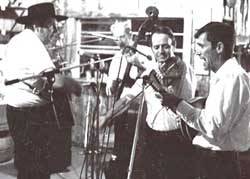
These numbers were recorded during two different sessions in late spring, 1980, in the makeshift studio set up in Troy DeRamus' Old Barn in Boyce, Louisiana. During the first session, several state fiddling champions were invited to join the string band as guest performers in order to obtain recordings documenting individual styles of Louisiana fiddlers. Technical difficulties with the recording arose limiting the number of usable recordings produced in the first session; consequently, only four selections are included on the record. These remarkable unrehearsed selections feature past champions in fiddling: Tex Grimsley and Eddie Raxsdale and banjo champion, Dennis Elliott.
With these and the remaining songs recorded by the four-piece North Louisiana String Band in the second session a few weeks later, side two presents fiddling styles of three North Louisiana fiddlers. Styles vary according to the individual and the type of music played, be it old-time, western swing, or bluegrass. Often it takes a trained ear to tell the differences. Eddie Raxsdale describes some fiddling differences: "I don't guess there are any two fiddlers I ever heard who play exactly alike. Where one man might play a tune and put three or four grace notes between each bar and the next man might put fifteen or sixteen, and that's what really makes the difference." Eddie does not see too much difference between his and Ray Beebe's style, which Eddie terms "Tennessee or Kentucky" style. He sees Texas Swing as having basically the same melody as the Tennessee style with more grace notes and different bowing. He explains it further: "Say you're playing a tune. If a fiddler plays a tune in Tennessee style, you might have in a bar of music, you might have three strokes of the bow, while in a Texas swing fiddle, you play the same amount of notes with only one stroke of the bow. It's the finger work and the coordination that makes the difference. . . . In other words, I might walk from here to that building over there in thirty steps and it might take you forty-five to make the same walk."
1. Boil Them Cabbage Down
Also known as "Bile dem Cabbage down," this is an old black dance tune (Scarborough 1925: 124), perhaps dating back to slavery. It was often used in minstrel shows and later performed and recorded by country musicians such as Gid Tanner and the Skillet Lickers (Columbia 15249), Fiddlin' John Carson (Okeh 4511), and Uncle Dave Macon (Vocalion 14849). This version shows Ray Beebe's strength in breakdown fiddling.
2. Rubber Dolly
This tune is often performed with lyrics, but here Tex Grimsley gives an instrumental interpretation with a Texas Swing style fiddle, supported by Don Mayo's mandolin, Troy DeRamus' rhythm guitar, and Herman White's bass.
Two-time Louisiana State Fiddling Champion in 1977 and 1980, Tex Grimsley, of Bossier City, Louisiana, learned to play fiddle at the age of seven. He is known as one of the best western swing fiddlers in the area. A songwriter also, he is especially proud of his "Walking the Dog," which he wrote for Webb Pierce, the popular country honky-tonk singer from Monroe, Louisiana. In addition to his fiddling skill, Tex also builds and repairs fiddles.
3. Before I Met You
Troy DeRamus sings lead on this mountain folk song, which he learned from Ray Beebe about twenty-five years ago. Ray was performing it before Lester Flatt's recording popularized it. He is joined on the chorus by Don Mayo's tenor and Herman White's bass to recreate the basic country harmony heard in old hillbilly and gospel songs.
I thought I had seen pretty girls in my life.
But that was before I met you
I'd never seen one that I wanted for mine.
But that was before I met you.(Chorus:) I thought I was swinging the world by the tail
I thought I would never be blue,
I thought I'd been kissed, and I thought I'd been loved
But that was before I met you.(Chorus)
They say I must reap just what I have sown,
But, Darling, I hope that's not true,
'Cause one time I made plans about living alone,
But that was before I met you.
4. Old Joe Clark
Ray Beebe - Lead fiddle Don Mayo - Mandolin
Eddie Raxsdale - Tenor fiddle Herman White - Bass
Tex Grimsley - Alto fiddle Troy DeRamus - Rhythm Guitar
All three fiddlers at the first recording session play together on this play party or dance song widely known throughout the South. When someone at the session suggested that they all play one together, this was one of the first ones, which came to mind. The numerous verses (cited in Belden 1952: 120 and Randolph 1950: 324) are not sung in this instrumental version.
5. Say Old Man, Can You Play The Fiddle?
Eddie Raxsdale plays fiddle on this old tune, supported with the mandolin, guitar, and bass. Although he could not remember exactly when the learned it, he thought he probably first heard it on the Grand Old Opry during his early years. The descending scale at the end of the lines is reminiscent of hornpipe music, popular in the Mississippi Valley.
6. Goodnight, Irene
This number is a good example of the interplay and exchange between popular and folk tradition and between white and black tradition. Although the melody's origin is not certain, it is most often thought to be of written origin from the Stephen Foster or "Sweet Adeline" vintage (White 1928: 235). It was popularized by North Louisiana born Huttie Ledbetter ("Leadbell""), who learned the refrain and a couple of verses from his uncle. Before his imprisonment, Leadbelly added some new verses, thus creating one of the best-known traditional black folksongs. The song was popularized by groups such as the Weavers and the Kingston Trio and then fed back into the Anglo folksong tradition.
DeRamus sings lead, backed by Mayo and White harmony, mandolin and bass, and Ray Beebe plays fiddle.
Last Saturday night I got married
Me and my wife settled down.
Now me and my wife are parted;
I'm gonna take another stroll downtown.(Chorus:) Irene, goodnight, Irene, goodnight
Goodnight, Irene, goodnight, Irene,
I'll see you in my dreams.Stop your ramblin', stop your gamblin';
Stop staying out late at night;
Go home to your wife and your family,
And stay by your fireside bright.(Chorus twice)
7. Soppin' The Gravy
This tune, which Ray Beebe insisted on including in the album, is probably an old-time number, but notes were not available under this title. Another breakdown, this tune is more heavily bowed in parts and shows some blues influence.
8. Golden Slippers
This version of this old-time tune is repeated (see notes on side one) to give a comparison demonstrating how the addition of the banjo to the basic string band may be handled. Dennis Elliott, of Pineville, Louisiana, the Louisiana State Banjo champion 1979 and 1980, joins the group to make a five-piece band. Dennis' banjo has a heavy influence from bluegrass, often using the banjo as lead instrument rather than rhythm and including more improvisation and grace notes added to the basic melody. It is not surprising that Dennis finds it difficult to restrain his banjo, for he grew up playing in his family's bluegrass band, Homespun Bluegrass. Elliott also plays a variety of fiddle styles from old-time to bluegrass to jazz violin. On a music scholarship at Loyola University, Dennis will no doubt make a career of music. It remains to be seen how much of his traditional background he will retain after a formal education.
At any rate, when fiddler Tex Grimsley sat and listened to this version, he commented, "You can't make country music prettier than that."12
Notes
1. Archie Green (1965), who purports that the term hillbilly was born out of the marriage of the commercial phonograph industry with the traditional Appalachian folksong, traces in detail the use of the pejorative, yet humorous term "hillbilly" in regard to country music.
2. For a thorough discussion of the lines of development of country music, see Malone (1968); Wilgus (1971), and Green (1965).
3. Lomax (1959: 931) provides an extensive discussion of folk song style.
4. Malone (1968: 13-15).
5. Green (1965), Wolfe (1977), and Malone (1968) all provide lengthy discussions of this recording period, its agents, artists, and accomplishments.
6. All quotations and personal histories of band members were obtained in personal interviews with the musicians. I deeply regret that I did not have an in-depth taped interview with Ray Beebe. His biography was compiled from my notes of our conversations and from information from the band members. Interviews with band members were conducted in the fall of 1979 and spring of 1980.
7. See Malone (162-164) for details of honky-tonk effects. The advent of "sock rhythm" -- the playing of closed chords, or the striking of all six strings in unison -- became the popular rhythm for guitar. This is the type of rhythm Troy DeRamus says he uses in the string band. Also see Malone, Chapter six for western swing influence.
8. The development and popularity of bluegrass, a relatively recent style, over the last thirty years has influenced many of the younger North Louisiana fiddlers, such as Dennis Elliott. However, the North Louisiana String Band does not claim any bluegrass features. See Malone (1968) chapter ten for a description of bluegrass style.
9. Although much of Central Louisiana, especially near Alexandria and the Red River and Natchitoches, is much flatter than the hill country to the north, Central Louisiana is still part of the piney woods and was settled predominantly by British Americans. It is, therefore, still considered North Louisiana. North Louisiana residents often see any place a little further south of Alexandria as South Louisiana; in fact, the Bunny Bread sign south of Bunkie is often joked of as the dividing line. However, scholars are more apt to draw the line less clearly and further south.
10. It is not surprising that the Mayo's would choose the Louvins as a model, for they shared much in common. The Louvins learned old-time country and gospel in Alabama and used them to begin their commercial career. They played mandolin and guitar and sang close high-pitched harmony in their pure country style.
11. In regard to the notes on the songs, I should state that no attempt has been made to provide extensive documentation of origins and previous recordings. Available information, which seemed applicable was included. It seemed more important to offer available contextual data and the musicians' perspectives. I regret that I was designated to do the notes after the recordings were made and was, consequently, not able to gather material directly. I would like to thank Archie Green and Nick Spitzer for their organizational suggestions and help with the research on the songs.
12. As quoted by Hatley in the Natchitoches Times, May 15, 1980.
Selected Bibliography
Asch, Moses and Alan Lomax, eds. 1962.The Leadbelly Songbook. New York: Oak Publications.
Belden, H.M. 1940. Ballads and Songs Collected by the Missouri Folklore Society. Columbia, Mo.: University of Missouri Studies.
Belden, H.M. and Arthur P. Hudson, eds. 1952. Folksongs from North Carolina, Vol. 3, The Frank C. Brown Collection of North Carolina Folklore, ed. I. N. White. Durham, N.C.: Duke University Press.
Cohen, Norman. 1965. "The Skillet Lickers: A Study of a Hillbilly String Band and its Repertoire". Journal of American Folklore, 78(309): 230-244.
Combs, Josiah H. 1967. Folksongs of the Southern United States, ed. D.K. Wilgus. Austin, Texas: University of Texas: University of Texas Press.
Davis, Arthur Kyle. 1937. Folksongs of Virginia. Durham, N.C.: Duke University Press.
Fleischhaur, Carl and Alan Jabbour. 1973. The Hammons Family: A Study of a West Virginia Family's Tradition. Washington: Library of Congress.
Green, Archie. 1965. "Hillbilly Music: Source and Symbol". Journal of American Folklore, 78(309): 204-227.
"String Bands". John Edwards Memorial Foundation Quarterly, pp. 215-224.
Hatley, Donald W. 1980."Louisiana Folklife Center Notes".Natchitoches Times, May 15, 1980
Jackson, Richard. 1976. Popular Songs of the Nineteenth Century. New York: Dover.
Lomax, Alan. 1960. Folksongs of North America. New York: Doubleday and Co.
1959. "Folksong Style". American Anthropologist, 61(6): 927-955.
Malone, Bill. 1985. Country Music, U.S.A. Austin, Texas: University of Texas Press.
Randolph, Vance. 1950. Ozark Folksong. Columbia, Missouri: The State Historical Society of Missouri.
Scarborough, Dorothy. 1925. On the Trail of the Negro Folksong. Cambridge: Harvard University Press.
White, Newman I. 1928. American Negro Folksongs. Cambridge: Harvard University Press.
Wilgus, D.K. 1959. British American Folksong Scholarship Since 1898. New Brunswick, New Jersey: Rutgers University Press.
1965. "An Introduction to the Study of Hillbilly Music". Journal of American Folklore, 78(309): 195-204.
1971. "Country-Western Music and the Urban Hillbilly". In The Urban Experience in Folklore Tradition, ed. E. Stekert and A. Paredes. Austin, Texas: The University of Texas Press.
Wolfe, Charles. 1977. "Tracking the Lost String Bands". In Southern Exposure: Long Journey Home, ed. Allen Tullos. Chapel Hill, North Carolina, 11-20.


